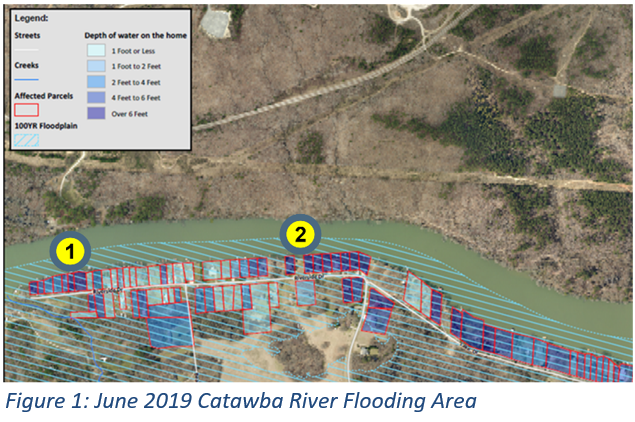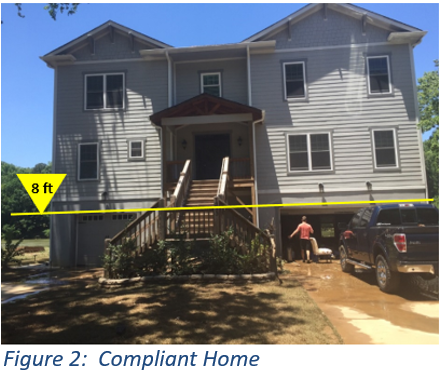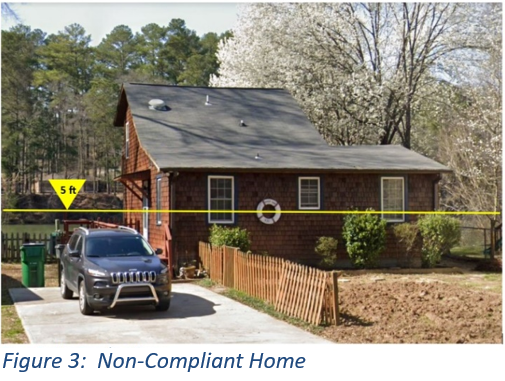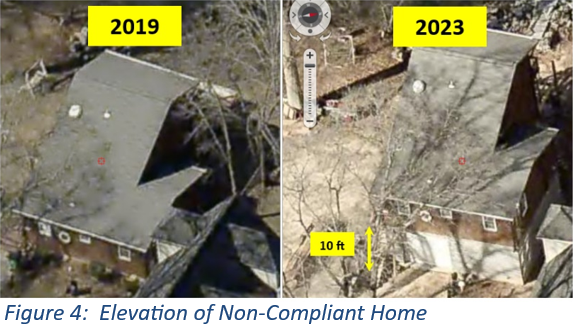|
Flood Recovery - A Tale of Two Homes
Reported by Don Ceccarelli, Mecklenburg County, NC
 “It has flooded here before but never to this extent;” this is a common quote from homeowners who have experienced flooding. If your home (and the homes of all your neighbors) were to unexpectedly flood tonight, what would you do, who would you turn to? This is the scenario that occurred in 2019 along the Catawba River in Charlotte, North Carolina. Nearly a hundred homes (and families) experienced flooding from a rainfall event two counties away and twenty (20) of those homes were substantially damaged by the flooding (Figure 1). Most of the homes in the area were not required to be built compliant with current floodplain standards due to construction date, but some homes were built (or rebuilt) compliant with current standards. This article compares recovery efforts from a non-compliant home (#1 in Figure 1) and a compliant home (#2 in Figure 1) and explores questions that local governments should consider, the answers to which can make communities floodplain resilient. When it comes to flooding, resiliency can be defined quite simply as the ability of a community to adjust and recover after a flood. “It has flooded here before but never to this extent;” this is a common quote from homeowners who have experienced flooding. If your home (and the homes of all your neighbors) were to unexpectedly flood tonight, what would you do, who would you turn to? This is the scenario that occurred in 2019 along the Catawba River in Charlotte, North Carolina. Nearly a hundred homes (and families) experienced flooding from a rainfall event two counties away and twenty (20) of those homes were substantially damaged by the flooding (Figure 1). Most of the homes in the area were not required to be built compliant with current floodplain standards due to construction date, but some homes were built (or rebuilt) compliant with current standards. This article compares recovery efforts from a non-compliant home (#1 in Figure 1) and a compliant home (#2 in Figure 1) and explores questions that local governments should consider, the answers to which can make communities floodplain resilient. When it comes to flooding, resiliency can be defined quite simply as the ability of a community to adjust and recover after a flood.
 During the flood, the floodplain compliant home (Figure 2) experienced flooding to depths of eight feet. This home was built to local floodplainstandards, which required finished spaces to be elevated two feet above the Federal Emergency Management Agency (FEMA) standards. The flooding impacts to the home were limited to an electrical meter being flooded, two propane tanks were dislodged, and the contents of the garage were flooded. The recovery efforts included getting an electrical contractor to replace the electrical meter, having the propane supplier properly secure the propane tanks, and removing the garage contents outdoors to dry, all of which took one to two weeks to complete. One of the most important after-flood facts, the homeowner and his family never had to vacate their home after the flood. During the flood, the floodplain compliant home (Figure 2) experienced flooding to depths of eight feet. This home was built to local floodplainstandards, which required finished spaces to be elevated two feet above the Federal Emergency Management Agency (FEMA) standards. The flooding impacts to the home were limited to an electrical meter being flooded, two propane tanks were dislodged, and the contents of the garage were flooded. The recovery efforts included getting an electrical contractor to replace the electrical meter, having the propane supplier properly secure the propane tanks, and removing the garage contents outdoors to dry, all of which took one to two weeks to complete. One of the most important after-flood facts, the homeowner and his family never had to vacate their home after the flood.
 During the flood, the floodplain non-compliant home (Figure 3) experienced flooding to depths of five feet. Due to its age, this home was not built to local floodplain standards or FEMA floodplain standards. As a result, the flooding impacts to the home were numerous: living spaces flooded, electrical systems damaged, water damage and mold issues to wallboard, insulation, and furniture. The homeowner initially stayed in his home after the flood, but upon inspection, building inspectors considered the structure uninhabitable due to the damage. The homeowner did not have flood insurance and now had to find alternate living arrangements within days. During the flood, the floodplain non-compliant home (Figure 3) experienced flooding to depths of five feet. Due to its age, this home was not built to local floodplain standards or FEMA floodplain standards. As a result, the flooding impacts to the home were numerous: living spaces flooded, electrical systems damaged, water damage and mold issues to wallboard, insulation, and furniture. The homeowner initially stayed in his home after the flood, but upon inspection, building inspectors considered the structure uninhabitable due to the damage. The homeowner did not have flood insurance and now had to find alternate living arrangements within days.
 The homeowner did find temporary living arrangements and rather than demolish the structure, elected to repair, and elevate the existing structure (Figure 4). The repairs were costly and time-consuming. The repairs began in 2019 and due to construction delays and the discovery of an unusable foundation, construction is ongoing as of July 2023. This is a 4-year recovery period for this homeowner. Is this resiliency? The homeowner did find temporary living arrangements and rather than demolish the structure, elected to repair, and elevate the existing structure (Figure 4). The repairs were costly and time-consuming. The repairs began in 2019 and due to construction delays and the discovery of an unusable foundation, construction is ongoing as of July 2023. This is a 4-year recovery period for this homeowner. Is this resiliency?
Is it the job of local leaders / governments to move their communities towards flood resiliency? If so, what steps can be taken? Some things to consider:
- Do you know where the floodplains are in your community? Floodplain maps offer you a guide to where flooding is likely to occur and help you dispatch recovery personnel during and after a flood. Some communities have gone as far as to prepare flood inundation maps (or use machine learning tools to create maps) based on different rainfall scenarios.
- Have you contacted FEMA (before it floods) to ask how they would respond to a flood in your area and coordinate how your staff can assist (and more importantly learn from) them during / after a flood? Collection of information like high water marks, flood damage estimates, etc. is valuable to FEMA and state officials for determining disaster declarations and access to emergency funding.
- Do you have the resources / funding to devote to funding a flood program? Operating your own floodplain program gives you the flexibility to go above FEMA standards to reduce flood risk (and increase resiliency) to levels that local officials determine appropriate.
- Do you educate and promote flood insurance to homeowners located in (and nearby) the floodplain? Flood insurance provides a defined funding source for flood recovery and offers other benefits for homeowners. If a local government operates a floodplain program approved by the National Flood Insurance Program (NFIP), discounted flood insurance (up to 45% discount) can be offered to residents if the local government implements measure above the NFIP minimum.
- Can you make it easier for floodplain non-compliant homes to become compliant by offering incentives (cost-sharing, reduction in utility fee, etc.) for homeowners that voluntarily pursue this option or providing materials on contractors that perform this type of service?
Gaining political and community support for planning and implementing these considerations can be difficult, challenging, and yes costly, and it may take a large flood event in your community for local leaders to act. However, dealing with difficult, challenging, and costly issues BEFORE a flood is better than dealing with difficult, challenging, and costly problems AFTER a flood.
|


 “It has flooded here before but never to this extent;” this is a common quote from homeowners who have experienced flooding. If your home (and the homes of all your neighbors) were to unexpectedly flood tonight, what would you do, who would you turn to? This is the scenario that occurred in 2019 along the Catawba River in Charlotte, North Carolina. Nearly a hundred homes (and families) experienced flooding from a rainfall event two counties away and twenty (20) of those homes were substantially damaged by the flooding (Figure 1). Most of the homes in the area were not required to be built compliant with current floodplain standards due to construction date, but some homes were built (or rebuilt) compliant with current standards. This article compares recovery efforts from a non-compliant home (#1 in Figure 1) and a compliant home (#2 in Figure 1) and explores questions that local governments should consider, the answers to which can make communities floodplain resilient. When it comes to flooding, resiliency can be defined quite simply as the ability of a community to adjust and recover after a flood.
“It has flooded here before but never to this extent;” this is a common quote from homeowners who have experienced flooding. If your home (and the homes of all your neighbors) were to unexpectedly flood tonight, what would you do, who would you turn to? This is the scenario that occurred in 2019 along the Catawba River in Charlotte, North Carolina. Nearly a hundred homes (and families) experienced flooding from a rainfall event two counties away and twenty (20) of those homes were substantially damaged by the flooding (Figure 1). Most of the homes in the area were not required to be built compliant with current floodplain standards due to construction date, but some homes were built (or rebuilt) compliant with current standards. This article compares recovery efforts from a non-compliant home (#1 in Figure 1) and a compliant home (#2 in Figure 1) and explores questions that local governments should consider, the answers to which can make communities floodplain resilient. When it comes to flooding, resiliency can be defined quite simply as the ability of a community to adjust and recover after a flood. During the flood, the floodplain compliant home (Figure 2) experienced flooding to depths of eight feet. This home was built to local floodplainstandards, which required finished spaces to be elevated two feet above the Federal Emergency Management Agency (FEMA) standards. The flooding impacts to the home were limited to an electrical meter being flooded, two propane tanks were dislodged, and the contents of the garage were flooded. The recovery efforts included getting an electrical contractor to replace the electrical meter, having the propane supplier properly secure the propane tanks, and removing the garage contents outdoors to dry, all of which took one to two weeks to complete. One of the most important after-flood facts, the homeowner and his family never had to vacate their home
During the flood, the floodplain compliant home (Figure 2) experienced flooding to depths of eight feet. This home was built to local floodplainstandards, which required finished spaces to be elevated two feet above the Federal Emergency Management Agency (FEMA) standards. The flooding impacts to the home were limited to an electrical meter being flooded, two propane tanks were dislodged, and the contents of the garage were flooded. The recovery efforts included getting an electrical contractor to replace the electrical meter, having the propane supplier properly secure the propane tanks, and removing the garage contents outdoors to dry, all of which took one to two weeks to complete. One of the most important after-flood facts, the homeowner and his family never had to vacate their home  During the flood, the floodplain non-compliant home (Figure 3) experienced flooding to depths of five feet. Due to its age, this home was not built to local floodplain standards or FEMA floodplain standards. As a result, the flooding impacts to the home were numerous: living spaces flooded, electrical systems damaged, water damage and mold issues to wallboard, insulation, and furniture. The homeowner initially stayed in his home after the flood, but upon inspection, building inspectors considered the structure uninhabitable due to the damage. The homeowner did not have flood insurance and now had to find alternate living arrangements within days.
During the flood, the floodplain non-compliant home (Figure 3) experienced flooding to depths of five feet. Due to its age, this home was not built to local floodplain standards or FEMA floodplain standards. As a result, the flooding impacts to the home were numerous: living spaces flooded, electrical systems damaged, water damage and mold issues to wallboard, insulation, and furniture. The homeowner initially stayed in his home after the flood, but upon inspection, building inspectors considered the structure uninhabitable due to the damage. The homeowner did not have flood insurance and now had to find alternate living arrangements within days. The homeowner did find temporary living arrangements and rather than demolish the structure, elected to repair, and elevate the existing structure (Figure 4). The repairs were costly and time-consuming. The repairs began in 2019 and due to construction delays and the discovery of an unusable foundation, construction is ongoing as of July 2023. This is a 4-year recovery period for this homeowner. Is this resiliency?
The homeowner did find temporary living arrangements and rather than demolish the structure, elected to repair, and elevate the existing structure (Figure 4). The repairs were costly and time-consuming. The repairs began in 2019 and due to construction delays and the discovery of an unusable foundation, construction is ongoing as of July 2023. This is a 4-year recovery period for this homeowner. Is this resiliency?